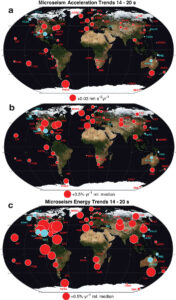Seismology records growing rumble of climate change – Warner College of Natural Resources
Seismology records growing rumble of climate change - Warner ... Colorado State University


Introduction
Since the late 1980s, modern digital seismic stations around the world have been taking the planet’s pulse. The low, steady thrum of ocean waves – once considered background noise by seismologists – has been intensifying since the late 20th century, according to a study led by Colorado State University.
Study Details
The study, published in Nature Communications, examines data from 52 seismic stations recording the motions of the Earth once per second for more than 35 years. This decades-long record supports independent climate and ocean research that suggests that storms are intensifying as the climate warms.
“Seismology can provide stable and quantitative measures of what’s going on with the world’s ocean waves and complements studies using satellite, oceanographic and other methods,” said lead author Rick Aster, a CSU geophysics professor and head of the Department of Geosciences. “The seismic signal is both consistent with these other studies and shows the sorts of features that we may expect from anthropogenic climate change.”
Aster and his co-authors with the U.S. Geological Survey and Harvard University studied the primary microseism – a seismic signal created by large, long-period waves as they roll across shallower areas of the global ocean. The seafloor in coastal regions experiences the constant push and pull of these waves, and these pressure variations generate seismic waves that are picked up by seismographs.
Seismographs are best known for monitoring and studying earthquakes, but they also detect many other things, including glacial movements, landslides, volcanic eruptions, large incoming meteors and noise from cities. Seismic waves from diverse forces on the surface or inside the Earth can be identified at great distances, even in some cases on the opposite side of the world.
Making (bigger) waves

Seismic signals showed that waves in the notoriously stormy Southern Ocean around Antarctica were, predictably, the most intense on the planet, but North Atlantic waves have intensified the most rapidly in recent decades, reflecting intensifying storms between eastern North America and western Europe.
Multi-year climate patterns like El Niño and La Niña, which influence the strength and distribution of global storms, also can be observed in the data, in addition to a steady climb in wave energy that mirrors the widespread increase in global ocean and air temperatures and larger storms.
“It’s clear that we’re seeing the general signal of storm activity around the world in these long-term seismic records in addition to a long-term intensification, attributed to global warming,” Aster said. “It seems like a small signal from year to year, but it’s progressive and becomes very clear when you’ve got 30-plus years of data to work with.”
Aster and his colleagues found that globally averaged ocean wave energy has increased at a median rate of 0.27% per year since the late 20th century and 0.35% per year since January 2000.
Stormy forecast
Aster said bigger waves and bigger storm-related surges, combined with rising sea level, are a serious, global issue for coastal ecosystems, cities and infrastructure.
“We’re going to have to implement resilient strategies, as well as to try to mitigate climate change itself, to ensure that our coastal populations and ecosystems are going to be protected from an increasingly stormy future,” Aster said.
Professor Rick Aster further explains this research in an article written for The Conversation: “How global warming shakes the Earth: Seismic data show ocean waves gaining strength as
SDGs, Targets, and Indicators
-
SDG 13: Climate Action
- Target 13.1: Strengthen resilience and adaptive capacity to climate-related hazards and natural disasters
- Target 13.2: Integrate climate change measures into national policies, strategies, and planning
- Target 13.3: Improve education, awareness-raising, and human and institutional capacity on climate change mitigation, adaptation, impact reduction, and early warning
- Target 13.a: Implement the commitment undertaken by developed-country parties to the United Nations Framework Convention on Climate Change to a goal of mobilizing jointly $100 billion annually by 2020 from all sources to address the needs of developing countries in the context of meaningful mitigation actions and transparency on implementation and fully operationalize the Green Climate Fund through its capitalization as soon as possible
- Target 13.b: Promote mechanisms for raising capacity for effective climate change-related planning and management in least developed countries and small island developing States, including focusing on women, youth, and local and marginalized communities
The article highlights the intensification of ocean waves as a result of climate change. This connects to SDG 13, which focuses on climate action. The targets mentioned above are relevant to addressing the issues discussed in the article.
-
SDG 14: Life Below Water
- Target 14.2: Sustainably manage and protect marine and coastal ecosystems to avoid significant adverse impacts, including by strengthening their resilience and take action for their restoration in order to achieve healthy and productive oceans
- Target 14.3: Minimize and address the impacts of ocean acidification, including through enhanced scientific cooperation at all levels
- Target 14.5: By 2020, conserve at least 10 percent of coastal and marine areas, consistent with national and international law and based on the best available scientific information
- Target 14.7: By 2030, increase the economic benefits to small island developing States and least developed countries from the sustainable use of marine resources, including through sustainable management of fisheries, aquaculture, and tourism
The article discusses the impact of intensifying ocean waves on coastal ecosystems and infrastructure. This aligns with SDG 14, which focuses on life below water. The targets mentioned above are relevant to addressing the issues highlighted in the article.
| SDGs | Targets | Indicators |
|---|---|---|
| SDG 13: Climate Action |
|
No specific indicators mentioned in the article. |
| SDG 14: Life Below Water |
|
No specific indicators mentioned in the article. |
Behold! This splendid article springs forth from the wellspring of knowledge, shaped by a wondrous proprietary AI technology that delved into a vast ocean of data, illuminating the path towards the Sustainable Development Goals. Remember that all rights are reserved by SDG Investors LLC, empowering us to champion progress together.
Source: warnercnr.source.colostate.edu

Join us, as fellow seekers of change, on a transformative journey at https://sdgtalks.ai/welcome, where you can become a member and actively contribute to shaping a brighter future.







